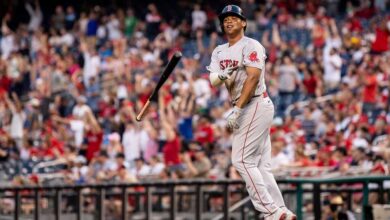

The month of April has given fantasy owners several surprises in the form of pitching. Perennial studs like Matt Cain, Cole Hamels and Stephen Strasburg have struggled to a certain degree. Young hurlers such as Matt Moore and Matt Harvey are proving their worth.
Meanwhile, some question marks continue to linger with other pitchers. Some pitchers have aroused excitement in one month after entering the season with timid fantasy value. Others are blowing the doors off expectations. The latter can be attributed to Boston Red Sox righty Clay Buchholz. His first month of the season has been as impressive as any pitcher in Major League Baseball. The time to sell him high is now.
The return of John Farrell to Boston was expected to enhance the competency of the pitchers he once coached prior to leaving for Toronto. In one quick month, it’s obvious that Farrell is doing something right with his staff.
Clay Buchholz’s claim to fame is he threw a no-hitter in his second career MLB start. Since then, his ceiling has expanded skyward. Unfortunately, several injuries, such as a torn fingernail and a stress fracture in his back, brought expectations back to earth.
In 2010, Clay Buchholz pitched to 17 wins in 173.2 innings pitched while striking out 120. This performance would earn the righty a four-year contract extension worth nearly $40 million. Unfortunately, Clay Buchholz would only win 17 games in 43 starts between 2011-2012. In each successive season following 2010, Clay Buchholz’s ERA jumped more than one run while his strikeout and walk rates plateaued.
The 2013 season has been a different story thus far. Clay Buchholz’s 5-0 start screams sell, sell, sell! His strikeout rate sits at 27.1 percent, up from 16.1 in 2012, 17.0 in 2011 and 16.9 in 2010. Additionally, his home runs per nine innings pitched (HR/9) is 0.24 thus far. That is down from an average of 1.57 between 2011-2012.
His runners left-on-base percentage (LOB%) is 90.2 percent. This is the fourth highest in all of MLB. According to FanGraphs, LOB% typically averages 70-72 percent per season. Quite simply, everything that could go right has done so for Buchholz early on.
This is not to suggest that Clay Buchholz will not turn in a good 2013 season. Instead, it is a recommendation to get a much larger return on the righty than your initial investment. According to ESPN, Buchholz had an average draft position (ADP) of 221.4. Therefore, the likes of Jeff Keppinger, Domonic Brown and Edwin Jackson were all drafted, on average, ahead of the Red Sox hurler.
Additionally, the return you can receive on Buchholz today will be larger than the return you will get on him a month from now. Why? His numbers will adjust accordingly. At worse, this means significant damage will be done to the right-handed pitcher shortly. At best, he will slowly see a decline in his production due to the equalizing of various factors.
For instance, Buchholz is likely to see his LOB% adjust to a more normal level. This means more runs will cross the plate, expanding his ERA of 1.19 to a higher level. Buchholz’s abnormally high strikeout rate will adjust, resulting in more runners reaching base or driving in runs. Finally, expect Buchholz to allow HRs at a much higher rate than his currently.
The possibility exists that Clay Buchholz’s boom in results is here to stay. Simply put, previous ailments could be to blame for setting him back in previous seasons. However, Buchholz is pitching like he has never pitched before, even in his 17-win season of 2010. And the fact that he was drafted late, when one’s roster was likely filled out with enough pitching, means he could be sold high enough to fill out another position of need. If this is the case, market Clay Buchholz like he is Gio Gonzalez and get a favorable rate of return before his market value loses luster.




